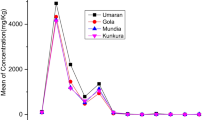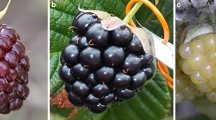Abstract
This study compared the phenolic composition and antioxidant properties of three varieties of fig fruits (Ficus carica L) from the Eastern Black Sea region of Türkiye. Total polyphenol content (TPC), total flavonoid content (TFC), and phenolic compositions were analyzed in green, purple, and dark purple species. The mean TPC value was 42.10 ± 5.71 mg GAE/100 g FW, ranging from 35.98 to 47.30 mg GAE/100 g FW, and was highest in the dark purple species. The mean TFC value was 1.27 ± 0.93 mg QUE/100 FW g, ranging between 0.35 and 2.21 mg QUE/100 FW g, and was highest in the purple species. The samples’ total antioxidant capacity was measured based on ferric reducing/antioxidant power (FRAP), the values ranging from 151.98 to 372.97 μmol FeSO4.7H2O/100 g FW, with an average value of 239.64 μmol FeSO4.7H2O/100 g FW, being highest in the dark purple species. The 2,2-Diphenyl-1-picrylhydrazyl (DPPH) radical scavenging activity of the fruits was expressed as SC50 (mg/mL), and the values ranged from 10.04 to 42.42 mg/mL, being highest in the purple species. The phenolic composition was analyzed using HPLC-PDA according to the method in which 25 phenolic standards were used. Chlorogenic acid and t-cinnamic acid were the most common phenolic compounds, with rutin, chrysin, apigenin, and luteolin being detected at different amounts. In conclusion, the purple species contained the highest flavonoid content, was rich in apigenin, luteolin, and chrysin, and possessed the highest DPPH radical scavenging activity.


Similar content being viewed by others
Data Availability
Not applicable.
References
del Río-Celestino M, Font R (2020) The health benefits of fruits and vegetables. Foods 9:369. https://doi.org/10.3390/foods9030369
Solomon A, Golubowicz S, Yablowicz Z et al (2006) Antioxidant activities and anthocyanin content of fresh fruits of common fig ( Ficus carica L.). J Agric Food Chem 54:7717–7723. https://doi.org/10.1021/jf060497h
Crisosto H, Ferguson L, Bremer V et al (2011) Fig ( Ficus carica L.). In: Yahia EM (ed) Postharvest biology and Technology of Tropical and Subtropical Fruits. Woodhead Publishing, pp 134–160e
Arvaniti OS, Samaras Y, Gatidou G et al (2019) Review on fresh and dried figs: chemical analysis and occurrence of phytochemical compounds, antioxidant capacity and health effects. Food Res Int 119:244–267. https://doi.org/10.1016/j.foodres.2019.01.055
Muminjanov H, Karagöz A (2018) Biodiversity of Turkey: contribution of genetic resources to sustainable agriculture and food systems. Food and Agriculture organization of the United Nations, Ankara
Çalışkan O, Polat A (2012) Morphological diversity among fig (Ficus carica L.) accessions sampled from the eastern Mediterranean region of Turkey. Turk J Agric For 36:179–193. https://doi.org/10.3906/tar-1102-33
Uslu NA, Özcan M, Aydin E (2022) Artvin, Giresun, Ordu illerinde Sofralık ve Reçellik İncir Seleksiyonu. Anadolu Tarım Bilimleri Dergisi 37:317–330. https://doi.org/10.7161/omuanajas.968849
Sezen I, Ercisli S, Gozlekci S (2014) Biodiversity of figs (Ficus carica L.) in Coruh valley of Turkey. Erwerbs-Obstbau 56:139–146. https://doi.org/10.1007/s10341-014-0222-6
Huang W-Y, Cai Y-Z, Zhang Y (2009) Natural phenolic compounds from medicinal herbs and dietary plants: potential use for Cancer prevention. Nutr Cancer 62:1–20. https://doi.org/10.1080/01635580903191585
Ramassamy C (2006) Emerging role of polyphenolic compounds in the treatment of neurodegenerative diseases: a review of their intracellular targets. Eur J Pharmacol 545:51–64. https://doi.org/10.1016/j.ejphar.2006.06.025
Rangel-Huerta OD, Pastor-Villaescusa B, Aguilera CM, Gil A (2015) A systematic review of the efficacy of bioactive compounds in cardiovascular disease: phenolic compounds. Nutrients 7:5177–5216. https://doi.org/10.3390/nu7075177
Veberic R, Colaric M, Stampar F (2008) Phenolic acids and flavonoids of fig fruit (Ficus carica L.) in the northern Mediterranean region. Food Chem 106:153–157. https://doi.org/10.1016/j.foodchem.2007.05.061
Yang X, Yu W, Ou Z et al (2009) Antioxidant and immunity activity of water extract and crude polysaccharide from Ficus carica L. Fruit. Plant Foods Hum Nutr 64:167–173. https://doi.org/10.1007/s11130-009-0120-5
Mawa S, Husain K, Jantan I (2013) Ficus carica L. (Moraceae): Phytochemistry, traditional uses and biological activities. Evid Based Complement Alternat Med 2013:1–8. https://doi.org/10.1155/2013/974256
Ercisli S, Tosun M, Karlidag H et al (2012) Color and antioxidant characteristics of some fresh fig (Ficus carica L.) genotypes from northeastern Turkey. Plant Foods Hum Nutr 67:271–276. https://doi.org/10.1007/s11130-012-0292-2
Trad M, Gaaliche B, Renard CMGC, Mars M (2013) Inter- and intra-tree variability in quality of figs. Influence of altitude, leaf area and fruit position in the canopy. Sci Hortic 162:49–54. https://doi.org/10.1016/j.scienta.2013.07.032
Kemal M, Esertaş ÜZÜ, Kanbur ED et al (2023) Characterization of the black cumin (Nigella sativa L.) honey from Türkiye. Food. Bioscience 53:102760. https://doi.org/10.1016/j.fbio.2023.102760
Fukumoto LR, Mazza G (2000) Assessing antioxidant and Prooxidant activities of phenolic compounds. J Agric Food Chem 48:3597–3604. https://doi.org/10.1021/jf000220w
Benzie IFF, Strain JJ (1996) The ferric reducing ability of plasma (FRAP) as a measure of “antioxidant power”: the FRAP assay. Anal Biochem 239:70–76. https://doi.org/10.1006/abio.1996.0292
Molyneux P (2004) The use of the stable free radical diphenylpicrylhydrazyl (DPPH) for estimating antioxidant activity. Songklanakarin J Sci Technol 26:211–219
Kara Y, Can Z, Kolaylı S (2022) Applicability of phenolic profile analysis method developed with RP-HPLC-PDA to some bee product. Braz Arch Biol Technol 65:e22210384. https://doi.org/10.1590/1678-4324-2022210384
Soni N, Mehta S, Satpathy G, Gupta RK (2014) Estimation of nutritional, phytochemical, antioxidant and antibacterial activity of dried fig (Ficus carica). J Pharmacogn Phytochem 3:158–165
Ganesan P, Kumar CS, Bhaskar N (2008) Antioxidant properties of methanol extract and its solvent fractions obtained from selected Indian red seaweeds. Bioresour Technol 99:2717–2723. https://doi.org/10.1016/j.biortech.2007.07.005
Purnamasari R, Winarni D, Permanasari AA et al (2019) Anticancer activity of methanol extract of Ficus carica leaves and fruits against proliferation, apoptosis, and necrosis in Huh7it cells. Cancer Inform 18:1176935119842576. https://doi.org/10.1177/1176935119842576
Çalişkan O, Aytekin Polat A (2011) Phytochemical and antioxidant properties of selected fig (Ficus carica L.) accessions from the eastern Mediterranean region of Turkey. Sci Hortic 128:473–478. https://doi.org/10.1016/j.scienta.2011.02.023
Mahmoudi S, Khali M, Benkhaled A et al (2016) Phenolic and flavonoid contents, antioxidant and antimicrobial activities of leaf extracts from ten Algerian Ficus carica L. varieties. Asian Pac J Trop Biomed 6:239–245. https://doi.org/10.1016/j.apjtb.2015.12.010
Panche AN, Diwan AD, Chandra SR (2016) Flavonoids: an overview. J Nutritional Sci 5:e47. https://doi.org/10.1017/jns.2016.41
Vallejo F, Marín JG, Tomás-Barberán FA (2012) Phenolic compound content of fresh and dried figs (Ficus carica L.). Food Chem 130:485–492. https://doi.org/10.1016/j.foodchem.2011.07.032
Kamiloglu S, Capanoglu E (2015) Polyphenol content in figs (Ficus carica L.): effect of sun-drying. Int J Food Prop 18:521–535. https://doi.org/10.1080/10942912.2013.833522
Bey MB, Louaileche H, Zemouri S (2013) Optimization of phenolic compound recovery and antioxidant activity of light and dark dried fig (Ficus carica L.) varieties. Food Sci Biotechnol 22:1613–1619. https://doi.org/10.1007/s10068-013-0258-7
Saral Ö (2023) An investigation into chestnut honeys from Artvin Province in Turkiye: their physicochemical properties, phenolic profiles and antioxidant activities. Chem Biodivers e202201162. https://doi.org/10.1002/cbdv.202201162
Gercek YC, Celik S, Bayram S (2022) Screening of plant pollen sources, polyphenolic compounds, fatty acids and antioxidant/antimicrobial activity from bee pollen. Molecules 27:117. https://doi.org/10.3390/molecules27010117
Can Z, Kara Y, Kolayli S, Çakmak I (2023) Antioxidant activity and phenolic composition of propolis from Marmara region, Turkey, J Apicultural Res 1–7. https://doi.org/10.1080/00218839.2022.2157582
Wallace TC, Giusti MM (2015) Anthocyanins. Adv Nutr 6:620–622. https://doi.org/10.3945/an.115.009233
Russo F, Caporaso N, Paduano A, Sacchi R (2014) Phenolic compounds in fresh and dried figs from Cilento (Italy), by considering Breba crop and full crop, in comparison to Turkish and Greek dried figs. J Food Sci 79:C1278–C1284. https://doi.org/10.1111/1750-3841.12505
Author information
Authors and Affiliations
Contributions
Çiğdem Bayrak: Formal analysis, writing the article; Ceren Birinci: HPLC studies; Mehmet Kemal: Formal analysis; Sevgi Kolaylı: Planning the study, writing and editing the article.
Corresponding author
Ethics declarations
Ethics Approval
Not applicable.
Consent to Participate
Not applicable.
Consent for Publication
Not applicable.
Conflict of Interest
The authors declare no conflict of interest.
Additional information
Publisher’s Note
Springer Nature remains neutral with regard to jurisdictional claims in published maps and institutional affiliations.
Rights and permissions
Springer Nature or its licensor (e.g. a society or other partner) holds exclusive rights to this article under a publishing agreement with the author(s) or other rightsholder(s); author self-archiving of the accepted manuscript version of this article is solely governed by the terms of such publishing agreement and applicable law.
About this article
Cite this article
Bayrak, Ç., Birinci, C., Kemal, M. et al. The Phenolic Composition and Antioxidant Properties of Figs (Ficus carica L.) Grown in the Black Sea Region. Plant Foods Hum Nutr 78, 539–545 (2023). https://doi.org/10.1007/s11130-023-01089-z
Accepted:
Published:
Issue Date:
DOI: https://doi.org/10.1007/s11130-023-01089-z




